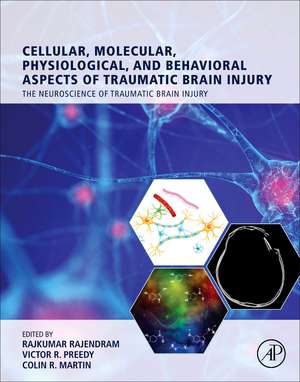Cellular, Molecular, Physiological, and Behavioral Aspects of Traumatic Brain Injury
Editat de Rajkumar Rajendram, Victor R. Preedy, Colin R Martinen Limba Engleză Hardback – 22 sep 2022
- Summarizes the neuroscience of traumatic brain injury, including cellular and molecular biology
- Contains chapter abstracts, key facts, dictionary, and summary points to aid in understanding
- Features chapters on signaling and hormonal events
- Includes plasticity and gene expression
- Examines health and stress behaviors after traumatic brain injury
Preț: 1155.09 lei
Preț vechi: 1498.22 lei
-23% Nou
Puncte Express: 1733
Preț estimativ în valută:
221.02€ • 231.39$ • 182.88£
221.02€ • 231.39$ • 182.88£
Carte indisponibilă temporar
Doresc să fiu notificat când acest titlu va fi disponibil:
Se trimite...
Preluare comenzi: 021 569.72.76
Specificații
ISBN-13: 9780128230367
ISBN-10: 0128230363
Pagini: 612
Ilustrații: Approx. 125 illustrations (125 in full color)
Dimensiuni: 216 x 276 mm
Editura: ELSEVIER SCIENCE
ISBN-10: 0128230363
Pagini: 612
Ilustrații: Approx. 125 illustrations (125 in full color)
Dimensiuni: 216 x 276 mm
Editura: ELSEVIER SCIENCE
Cuprins
Section 1. Setting the Scene: The Spectrum of Traumatic Brain Injuries
1. Slips, falls and traumatic brain injury
2. Road traffic accidents and traumatic brain injury
3. Sports, risks and brain injury
4. Traumatic brain injury and gunshot wounds
5. Blast waves and brain injury
6. Military veterans with brain injury
7. Gender and traumatic brain injury
8. Pediatric abusive head trauma and brain injury
9. Perinatal traumatic brain injury
10. Non traumatic brain injury:A focus on irradiation
11. The caregivers of traumatic brain injured subjects
Section 2. Cellular and Molecular Aspects of Traumatic Brain Injury
12. Subcellular organelles in traumatic brain injury: a focus on mitochondrial changes
13. Diffuse axonal injury and traumatic brain injury
14. Electrolytes and traumatic brain injury: a focus on sodium
15. Neurotransmitters and traumatic brain injury: a narrative
16. The role of prokineticin 2 in traumatic brain injury
17. Traumatic brain injury, and Leucine-rich repeat kinase 2 (LRRK2)
18. C-C motif chemokine receptor 5 and traumatic brain injury
19. Neuronal cell death pathways in traumatic brain injury
Section 3. Physiological and Metabolic Effects
20. Cerebral blood flow and traumatic brain injury
21. Traumatic brain injury and raised intracranial pressure
22. Oedema in traumatic brain injury
23. Traumatic brain injury and the vasculature: a focus on cerebral arteriole inflation
24. Elevated intracranial pressure in traumatic brain injury
25. Seizures in traumatic brain injury
26. Traumatic brain injury and impact on endocrinology: a focus on pituitary function
27. Sensory features and loss after traumatic brain injury: a focus on olfactory senses
28. Traumatic brain injury and impact on metabolism: a focus on hyperglycemia
29. Traumatic brain injury and impact on non-neurological body systems: a focus on bone
Section 4. Behavioural and Psychological Effects
30. Traumatic brain injury and mental health: military perspectives
31. A focus on depression in traumatic brain injury
32. Personality disturbances in brain trauma
33. Sleep and traumatic brain injury
34. Cognitive recovery and traumatic brain injury
35. Brain injury and resulting hallucinations
36. Use of smartphone application by subjects with traumatic brain injury
1. Slips, falls and traumatic brain injury
2. Road traffic accidents and traumatic brain injury
3. Sports, risks and brain injury
4. Traumatic brain injury and gunshot wounds
5. Blast waves and brain injury
6. Military veterans with brain injury
7. Gender and traumatic brain injury
8. Pediatric abusive head trauma and brain injury
9. Perinatal traumatic brain injury
10. Non traumatic brain injury:A focus on irradiation
11. The caregivers of traumatic brain injured subjects
Section 2. Cellular and Molecular Aspects of Traumatic Brain Injury
12. Subcellular organelles in traumatic brain injury: a focus on mitochondrial changes
13. Diffuse axonal injury and traumatic brain injury
14. Electrolytes and traumatic brain injury: a focus on sodium
15. Neurotransmitters and traumatic brain injury: a narrative
16. The role of prokineticin 2 in traumatic brain injury
17. Traumatic brain injury, and Leucine-rich repeat kinase 2 (LRRK2)
18. C-C motif chemokine receptor 5 and traumatic brain injury
19. Neuronal cell death pathways in traumatic brain injury
Section 3. Physiological and Metabolic Effects
20. Cerebral blood flow and traumatic brain injury
21. Traumatic brain injury and raised intracranial pressure
22. Oedema in traumatic brain injury
23. Traumatic brain injury and the vasculature: a focus on cerebral arteriole inflation
24. Elevated intracranial pressure in traumatic brain injury
25. Seizures in traumatic brain injury
26. Traumatic brain injury and impact on endocrinology: a focus on pituitary function
27. Sensory features and loss after traumatic brain injury: a focus on olfactory senses
28. Traumatic brain injury and impact on metabolism: a focus on hyperglycemia
29. Traumatic brain injury and impact on non-neurological body systems: a focus on bone
Section 4. Behavioural and Psychological Effects
30. Traumatic brain injury and mental health: military perspectives
31. A focus on depression in traumatic brain injury
32. Personality disturbances in brain trauma
33. Sleep and traumatic brain injury
34. Cognitive recovery and traumatic brain injury
35. Brain injury and resulting hallucinations
36. Use of smartphone application by subjects with traumatic brain injury
